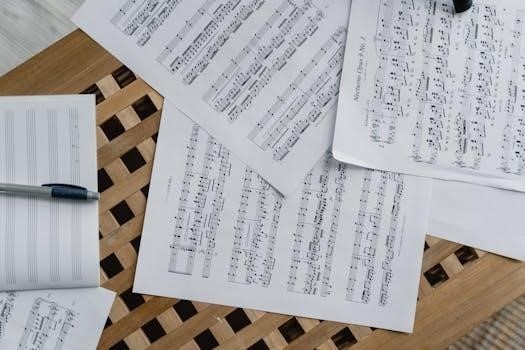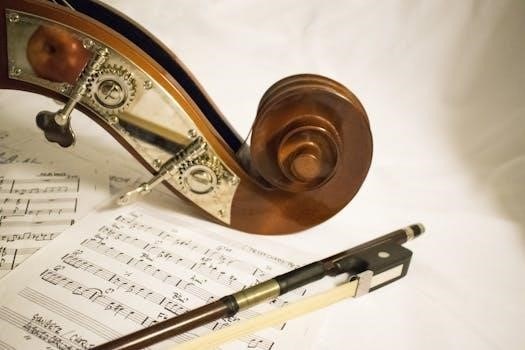Completed in 1824, Beethoven’s Ninth Symphony stands as a pinnacle of classical music. This choral symphony is renowned for its unique integration of voices, setting Schiller’s “Ode to Joy” in a dramatic finale. It remains a supreme model of extended symphonic form.
Overview and Significance
Beethoven’s Ninth Symphony, a monumental work completed in 1824, is often hailed as one of the greatest symphonies ever composed. Its significance lies not only in its musical complexity and emotional depth but also in its groundbreaking use of a chorus in the final movement. This innovative approach has cemented its place in music history. The symphony represents the culmination of Beethoven’s symphonic achievements and continues to inspire generations of musicians and listeners.

Composition and Creation
The Ninth Symphony was composed between 1822 and 1824, marking Beethoven’s final complete symphony. This period saw him explore new ideas, notably the inclusion of a choral finale, setting it apart.
Timeline of Composition (1822-1824)
Beethoven’s Ninth Symphony, a monumental work, took shape over the period of 1822 to 1824. During these years, Beethoven dedicated himself to exploring new musical concepts, culminating in the groundbreaking choral finale. This intense period of creation resulted in what many consider his greatest achievement, pushing the boundaries of symphonic form and introducing the power of vocal music into the orchestral realm. The symphony’s completion marked a significant milestone in the history of music.
The Unique Choral Element
The inclusion of a choral finale in Beethoven’s Ninth Symphony was a revolutionary concept for its time. This innovative addition brought the power of poetry and song directly into the symphonic fabric, setting Schiller’s “Ode to Joy.” This dramatic choral setting was unprecedented in orchestral music, blending vocal and instrumental forces in a way that had not been done before. The use of voices transformed the symphony, creating a truly unique and unforgettable musical experience, cementing its place in history.
The Music Score
The full score of Beethoven’s Ninth Symphony is available in various formats, including PDF. These scores allow for detailed study and performance, showing the complexities of the orchestral and choral writing.
Availability of PDF Full Scores
Numerous online resources offer downloadable PDF versions of the full orchestral score for Beethoven’s Ninth Symphony. These digital scores provide a convenient way for musicians, scholars, and enthusiasts to access and study the complete work. The availability of PDF format facilitates easy viewing on various devices, enabling detailed analysis of Beethoven’s complex orchestration. These versions often include all the instrumental parts and vocal lines, providing a comprehensive view of the symphony.
Vocal Score and Piano Reductions
Alongside full orchestral scores, vocal scores and piano reductions of Beethoven’s Ninth Symphony are widely available in PDF format. These arrangements offer practical alternatives for singers and pianists to rehearse and perform the work. Vocal scores typically include the choral parts with a piano accompaniment, while piano reductions condense the orchestral textures into a playable arrangement. These resources are invaluable for studying the vocal and harmonic aspects of the symphony, making it more accessible for individual study and performance.

Performance and Premiere
The premiere of Beethoven’s Ninth Symphony took place in Vienna on May 7, 1824. Beethoven himself was present, setting tempos while turning pages of his score, despite his profound deafness during the performance;
Beethoven’s Role During the Premiere
Despite his profound deafness, Beethoven played a vital role at the premiere of his Ninth Symphony. He sat by the stage, turning the pages of his score and indicating tempos to the orchestra, although he could not hear the music himself. This poignant scene highlights his dedication to his work, even amidst his personal challenges. His physical presence guided the performance, underscoring the composer’s integral connection to his creation.
Anecdotes and Historical Context
Numerous anecdotes surround the premiere of Beethoven’s Ninth Symphony, painting a vivid picture of the event. Some accounts suggest that despite his deafness, Beethoven was passionately involved in directing the performance. The symphony’s debut was a monumental occasion, deeply impacting the musical landscape of its time. The inclusion of a chorus was revolutionary, marking a significant departure from traditional symphonic structures and establishing a new standard in the history of music.

Analysis of the Symphony
The Ninth Symphony’s structure is notable, featuring a scherzo as its second movement, a deviation from typical symphonic form. The finale’s “Ode to Joy” is a powerful vocal setting of Schiller’s text, expressing universal brotherhood.
The Scherzo as the Second Movement
Beethoven’s placement of the Scherzo as the second movement in his Ninth Symphony was an innovative departure from traditional symphonic structures. Typically, the slow movement would follow the opening allegro, but Beethoven opted for a high-energy, rhythmic scherzo instead. This choice injected a unique sense of dynamism and forward momentum into the symphony’s progression, demonstrating Beethoven’s dedication to exploring new ideas within the symphonic form and showcasing his creative genius.
Ode to Joy⁚ Text and Musical Setting
The “Ode to Joy,” with lyrics by Friedrich Schiller, forms the core of the Ninth Symphony’s choral finale. Beethoven’s musical setting of this text is revolutionary, bringing together the power of poetry and song within the symphonic fabric. He masterfully crafts a powerful and uplifting musical narrative that perfectly encapsulates the essence of Schiller’s message of universal brotherhood and joy, creating a truly unique and impactful musical experience for listeners.
Editions and Scholarship
Scholarly-critical editions, notably by Jonathan Del Mar, are essential for understanding the Ninth Symphony. These editions focus on source criticism and performance practice, providing insights into Beethoven’s intentions, and addressing variations in the scores.
Scholarly-Critical Editions by Del Mar
Jonathan Del Mar’s work on Beethoven’s Nine Symphonies, particularly the Ninth, stands out for its rigorous approach to source criticism. These editions, published by Bärenreiter between 1996 and 2000, meticulously analyze original manuscripts and early prints. Del Mar’s aim was to provide a version of the score as close as possible to Beethoven’s intentions. His work addresses inconsistencies found in previous editions and aims to give a definitive resource for performers and scholars. This attention to detail has made his editions essential for serious study of the symphony.
Source Criticism and Performance Practice
The study of Beethoven’s Ninth Symphony benefits greatly from source criticism, which examines the original manuscripts and early prints. This approach, exemplified by the work of scholars like Jonathan Del Mar, informs modern performance practice. Attention is paid to Beethoven’s often imprecise notation, including dynamics and articulation. Furthermore, metronome markings are also analyzed, as well as evaluation of the sources. Such meticulous analysis allows for informed decisions that aim to recreate the composer’s original vision as faithfully as possible, even when they were not always clear in the original score.
Legacy and Influence
Beethoven’s Ninth holds a monumental place in music history, inspiring generations of composers. Its innovative choral finale and profound emotional depth have solidified its status. The original score is preserved in the UNESCO Memory of the World Register.
The Symphony’s Place in Music History
Beethoven’s Ninth Symphony is considered a cornerstone of Western classical music, marking a significant shift in symphonic form. Its introduction of a choral element in the finale was revolutionary, influencing countless composers after him. It expanded the boundaries of what a symphony could be, blending instrumental and vocal forces. The Ninth remains a powerful and enduring testament to Beethoven’s genius and its historical impact is undeniable.
UNESCO Memory of the World Register
The original score of Beethoven’s Ninth Symphony holds a place of honor on the UNESCO Memory of the World Register. This designation recognizes the symphony as a crucial part of the world’s cultural heritage. Its inclusion in the register highlights the work’s immense historical and artistic importance. It joins other significant documents that represent the spiritual heritage of humankind, signifying the Ninth’s global impact and enduring legacy. This recognition underscores its universal value.
Digital Resources
Numerous online platforms offer digital sheet music for Beethoven’s Ninth Symphony. These resources include full scores and various arrangements, often available in PDF or MIDI formats for download and study.
Online Sheet Music Availability
The digital age has made Beethoven’s Ninth Symphony incredibly accessible, with numerous online resources providing sheet music. Full scores, vocal scores, and piano reductions can be found in PDF format. These platforms cater to various needs, offering options for different instrumentations, including symphony orchestra, piano, and choral arrangements. Many sites also provide free downloads, while others offer premium versions, ensuring musicians and scholars have ample access to this monumental work.
Digital Sheet Music Download Options
Numerous digital platforms offer various download options for Beethoven’s Ninth Symphony, catering to diverse needs. Users can find full orchestral scores, vocal scores, and individual instrument parts in PDF format. These resources often include both free and paid options, with premium versions sometimes offering higher-resolution scans or additional features. Furthermore, many sites provide MIDI files alongside PDF scores, enabling users to interact with the music in digital audio workstations and explore different arrangements of the symphony.

Practical Information
The full score of Beethoven’s 9th Symphony typically has dimensions around 9.75 x 12.5 inches. Performance materials, including individual parts and vocal scores, are usually available for purchase separately.
Score Dimensions and Format
The full orchestral score of Beethoven’s Symphony No. 9 is often found in a substantial format, commonly measuring around 9.75 x 12.5 inches. This size accommodates the extensive instrumentation and complex notation of the work. The format is typically a bound book, with pages containing multiple staves to represent the various instrumental sections and vocal parts. This allows conductors and scholars to have a comprehensive view of the complete musical texture.
Performance Material Availability
Orchestral parts and choral scores for Beethoven’s Ninth Symphony are widely available for performance purposes. Publishers like Bärenreiter offer complete sets of performance materials, including individual instrumental parts and vocal scores. These materials are essential for orchestras and choirs preparing to perform the symphony. Digital versions of these parts are increasingly accessible, enabling quicker distribution and easier access for performing ensembles. These resources are vital for bringing Beethoven’s monumental work to life.
